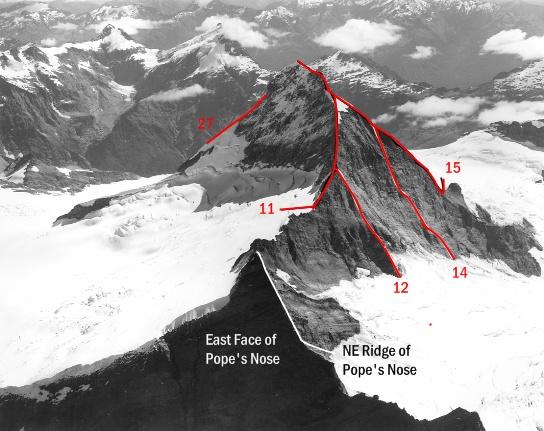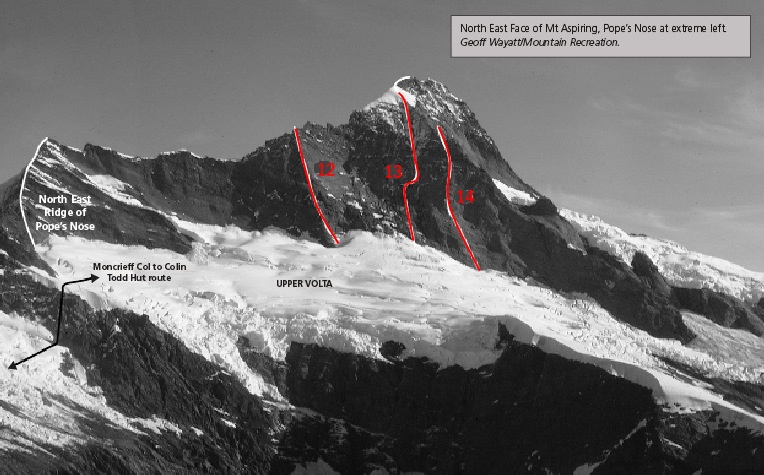Mount Aspiring is usually reached from Pearl Flat.
French Ridge Hut can be used as a base to climb the South West Ridge and South Face, Is the preferred route.
Bevan Col accesses Colin Todd Hut, which can be used as a base for the North Buttress, North West Ridge, South West Ridge and the Haast Range.
In winter or early spring it is generally better to use the French Ridge access routes to get to the Bonar Glacier. After the spring avalanche cycle, or when the Quarterdeck becomes impassable, use the Bevan Col route.
Places
| Type | Name | Alert |
|---|---|---|
| Face | South Face | |
| Face | North Face | |
| Face | North West Ridge | |
| Face | West Face | |
| Face | North East Face |
Routes
| Reference | Title | Grade | Length | Pro | Quality | Alert | Operations |
|---|---|---|---|---|---|---|---|
| 11 | 11Coxcomb Ridge, V,3+ | V,3+ | 0m | ||||
The first ascent of this long impressive ridge was made by Roy Beedham and Stuart Holmes on January 11, 1953. Two years previously, however, what very nearly turned out to be a successful ascent was made by D W Peacock, N O’Neill and M Pemberton, more or less by accident. After reaching a point estimated to be about 70 metres below the summit at 7pm they elected to retreat, eventually bivvying on the ridge at about 2835m, before returning to French Ridge the next day, minus success and the seats of their trousers. A few days later, having reached the summit by a more orthodox route, they were ruefully able to identify the point they had reached. The ridge is reached from the head of the Bonar at a snow col just west of Pope’s Nose. A lower set of gendarmes are rather rotten, but above these the quality of the rock improves. Most parties have preferred to keep to the northern side of the ridge as much as possible to avoid verglas. Near the top of the lower section of gendarmes is a prominent overhang, which has been turned on either side. The overhang is followed by a long snow arête, towards the top of which the Coxcomb is joined by the North East Ridge. Above this is a further series of gendarmes separated by snow or ice arêtes and including a three metre drop which is usually jumped, or can be rappelled if necessary, before a final short snow arête leads to the summit. Times for the route vary greatly. The ridge has been climbed in 5 hours; however, most competent parties in ropes of two could expect to take about 8–9 hours. |
|||||||
| 15 | 15North East Ridge (Surgeon Spur), IV,3 | IV,3 | 0m | ||||
The North East Ridge separates the Volta from the Therma Glacier. It was first climbed independently by two parties, Lindsay Bruce, Ian Bagley, Brian Wilkins, and Reg Scott, from Otago; and Dick Tornquist, Ivan Pickens, Jack Rattenbury, and J D Rockell, from Auckland, on January 4, 1955. The Otago party spent four nights out, two in a snow cave where the ridge meets the Coxcomb. To add to their discomfort they received shocks during an electrical storm. The whole epic makes absorbing reading and may have deterred subsequent attempts. However the third party on the climb found the route to be both practicable and enjoyable. It should be noted that the ridge merges with the upper part of the Coxcomb and that the most difficult pitches occur on the latter. Access from the top of Shipowner Ridge is by traversing the basin of the upper Therma and then up easy crevassed slopes to where the ridge is gained, either by the highest continuous snow tongue on to the ridge or by slabby pitches above a large rock tower, two to three hours from the hut. The ridge is exposed and generally of shattered rock; however, a long sidle on the eastern (Volta) side, about 15 metres below the ridge crest, allows many of the steeper pitches of the lower part of the ridge to be avoided. A more difficult section occurs higher up, before 200 metres of steep snow lead on to the Coxcomb Ridge. The remaining part of the Coxcomb appears to require at least as much time as the North East Ridge. The climb, including a descent by the North West Ridge has been done in 12 hours. |
|||||||
| 18 | 18North Buttress, III,13,3 | III,13,3 | 0m | ||||
The North Buttress is a strangely neglected route, offering as it does a direct and exacting rock climb on the sunny face of the mountain, with amazing views of the ocean as you’re climbing. From the crest of Shipowner Ridge descend into the upper basin of the Therma Glacier and cross easy crevassed slopes to the foot of the buttress. Easy slabs soon steepen to a 60 degree prominent light grey band, the top of which is about a third of the way up the climb. Cross the slabs going from right to left and go across a ledge which is very exposed over the North Face. Then follow the crest of the buttress. A series of gullies on the North Face should be on your left. Near the top of the buttress broken rock just to the east of the ridge crest is followed by a short pitch of snow before the final rock step, which is turned by shallow gullies on the east. A short snow or ice slope then leads directly to the summit. The rock grade is about 13 and if it gets any harder than that then you are possibly off route. When the buttress is iced up with riming the mixed climbing is good. Beware of falling ice. The first ascent began as a reconnaissance, but even with a three-man rope the climb was completed from the foot of the buttress in the remarkable time of 3 1/2 hours. |
|||||||
| 27 | 27South West Ridge, III,3+ | III,3+ | 0m | ||||
This is one of the classic climbs of the Southern Alps. The ridge is gained from the Bonar glacier, normally by its western flank at any convenient point below the rock band. About 150m below the summit, the ridge runs out into a steep open couloir, in which steep ice or even steep rock is often encountered, which nowadays is 80 degrees, before the ice cap and summit ridge are reached. Above the crux step there are about two 55–60 degree exposed pitches of potentially delicate snow and ice climbing to where the ridge joins the North West Ridge. This route is exposed to very cold wind so it's important to carry more clothes than you would normally expect. |
|||||||

